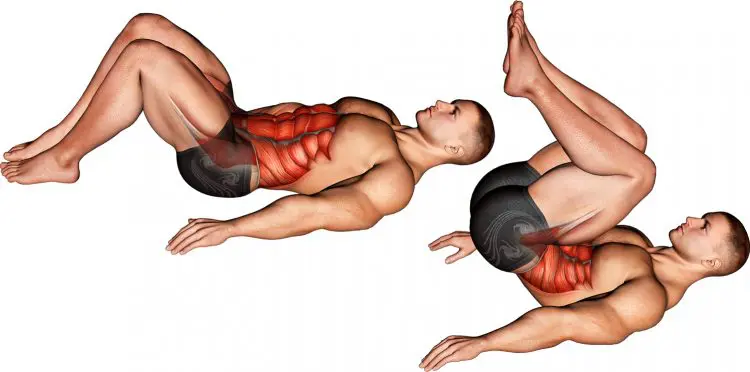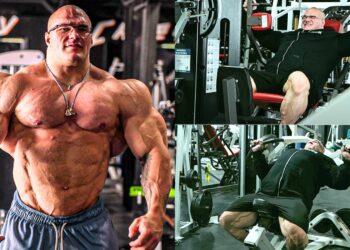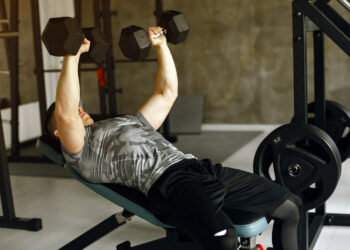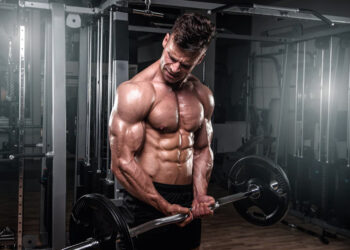The hip raise (bent knee) is a commonly performed exercise used to target the abdominals and strengthen the hip muscles. It’s a good movement for beginners and advanced exercisers as it’s relatively simple to do. Make no mistake though, it’s not easy but that’s why it’s effective.
Why this movement is great is because you use the weight of the legs to provide resistance and there are many great variations to help improve your core development.
Muscles Worked
The hip raise works several muscle groups although the core and hips are the main focus.

Adductor Brevis
Implied by the name of this inner thigh muscle, the adductor brevis is one of several adductors that helps draw the leg medially inward and flexes it at the hips.
Adductor Longus
Another addition to the adductor muscles, longus performs the same action as the brevis. It’s one of the three powerful thigh adductors along with the brevis and magnus.
Iliopsoas
A very important muscle of the inner thigh, iliopsoas is two muscles – psoas major and iliacus. It’s also the strongest hip joint flexor and supports movement and stabilization of the pelvis.
Level Up Your Fitness: Join our 💪 strong community in Fitness Volt Newsletter. Get daily inspiration, expert-backed workouts, nutrition tips, the latest in strength sports, and the support you need to reach your goals. Subscribe for free!
Rectus Abdominis
Hip bent raises are programmed to target the rectus abdominis otherwise known as the abdominals. These muscles activate when we raise the legs up or crunch the upper torso toward the belly button.
Obliques
While more of a rotational muscles, the obliques are engaged during crunching variations. Obliques are found on the outer edges of the rectus abdominis and they help us to twist the trunk and bend laterally.
Sartorius
Making the record books as the longest human muscle, sartorius moves both the hip and knee joint and externally rotates the thigh.
Tensor Fasciae Latae
Also a thigh muscle, tensor fascia latae works in conjunction with the glute or butt muscles to flex, abduct, and internally rotate the thigh. Its other functions are knee flexion and lateral rotation.
How To Do The Hip Raise (Bent Knee)
As simple as the hip raise (bent knee) is to do, those with less training experience may benefit from step-by-step instructions to ensure safe and proper form. Although, anyone may find this section useful.
- Lie on your back with your knee bent and feet flat on the floor, and place your hands down by your sides. Ideally, you’ll have a soft surface for comfort.
- While tensing your core muscles, bring your knees toward your chest and lift your hips just off the floor by rolling your pelvis back. Keep your legs bent and over your torso.
- Return to the starting position and repeat.
Here’s a video example…
Hip raise (bent knee) tips
- Do NOT use momentum to rock your body back and forth. The goal is to use your core and pelvis to contract your abdominal muscles.
- Use a comfortable surface to avoid experiencing pain or discomfort as this will affect your performance and make the experience not enjoyable.
- You want to squeeze your core muscles during the movement and rolling your pelvis back enhances the muscular contraction and exercise experience.
Benefits
Here are the main benefits of this exercise.
Improves core development
The main goal for most exercisers when doing similar exercises is to build the core muscles. A well-developed midsection has many benefits but aesthetics are a big one!
Washboard Abs: The Ultimate Guide
Stronger midsection
A strong midsection is crucial for heavy lifting, athletic performance, and longevity. The core muscles keep the midsection and spine stable which maximizes strength performance and prevents injuries.
A lot of lower back pain is caused by a weak core. Giving attention to these muscles can make a big difference in your daily life.
Strengthens hips
The hip flexors play a big role in lower body movement and function and this exercise involves hip flexion which keeps things mobile and functional.
Variations / Alternatives
While the hip raise (bent knee) is an excellent exercise that a lot of people can do, we also like the following variations/alternatives.
Straight leg and hip raise
If you want to step it up and have the flexibility to do so, try out the lying straight leg and hip raise. It’s actually more challenging not just because you have to keep the legs straight, but the weight of extended legs increases the difficulty of the exercise.
Hanging leg and hip raise
The hanging leg and hip raise is a more advanced variation. That’s because gravity has more of an effect, causing the weight of your legs to create a very challenging experience.
Level Up Your Fitness: Join our 💪 strong community in Fitness Volt Newsletter. Get daily inspiration, expert-backed workouts, nutrition tips, the latest in strength sports, and the support you need to reach your goals. Subscribe for free!
You can do it with knees bent or legs straight which is even harder to do.
You can also do the Captain’s chair variation which doesn’t require grip strength, and you can also more easily add weight if you reach that level of fitness.
Cocoons
Cocoons resemble exactly what the name implies because when performed, your body looks like a cocoon that encases insects.
It’s sort of a crunch and knee/hip raise combo so it really maximizes core contraction.
12 Crunches and Sit-Up Alternative That Will Give You A Shredded Midriff
Weighted hip raise (bent knee)
For more advanced exercisers, it’s not a bad idea to strap on some ankle weights for more resistance. Anytime you add more resistance to an exercise, you’re going to make more progress.
How To Incorporate The Hip Raise (bent knee) Into Your Training Routine
It’s certainly not our business to tell you how to train. But we always try and recommend a sensible approach to exercise as we believe strategy helps to maximize results.
We always suggest doing the harder exercises first when you’re strongest, especially if doing bodyweight workouts. Although, typically, movements that involve raising the legs are usually the most difficult due to the heavy weight of the legs.
So hanging leg raise variations would be the most challenging followed by lying or seated leg raise exercises.
Of course, any weighted movement can offer the same effect but are hardly as functional as moving around your own bodyweight.
You could then do crunches, and other similar exercises and finally move into standing core exercises.
Try this Savage Calisthenics Abs Workouts For Beast Gains (All Levels)
Sets and reps
The goal with bodyweight exercises should be to do as many as you can with good form. This will vary as not everyone is at the same level of fitness.
For people who cannot do many, for example, more than 4, then keep at it until you can do upwards of 20.
But if you can do endless reps, well, you should probably add weight or do another exercise that’s more challenging and that will cause your body to get stronger.
As for sets, anywhere from 2-4 is common depending on your level of training experience and goals.
Wrapping Up
If you need a good core-building exercise to add to your routine that requires nothing but you and a comfortable surface, the hip raise (bent knee) is a great option.
It’s no doubt challenging and when done right, will have your midsection screaming!
Plus, there are other great variations that you can do for a complete core training routine.
Interested in measuring your progress? Check out our strength standards for Hanging Leg Raise, Crunches.








